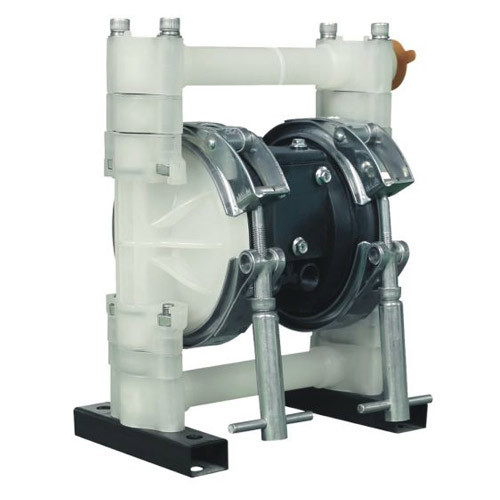Description
Air Operated Diaphragm Pumps in Pakistan
Air diaphragm pump (also called Pneumatic Diaphragm Pump) is a positive displacement pump that uses a combination of the reciprocating action of a diaphragm and suitable valves on either side of the diaphragm to pump a fluid.
Air Operated Diaphragm Pumps are designed for general use. They can easily pump from clean, light viscosity fluids to corrosive, abrasive medium viscosity fluids and can transfer large particles without damage. Due to their pneumatic motor, they could be used in potentially explosive areas. Most ARO® diaphragm pumps are ATEX certified (CE Ex11 2GD X).
Air Operated Diaphragm Pumps are designed for general use. They can easily pump from clean, light viscosity fluids to corrosive, abrasive medium viscosity fluids and can transfer large particles without damage. Due to their pneumatic motor, they could be used in potentially explosive areas. Most ARO® diaphragm pumps are ATEX certified (CE Ex11 2GD X).
Features:
-
Air powerd without electricity; It’s safe and reliable for flammable and explore places.
-
Pump with no dynamic seals, can dry running without damage to the pump.
-
All parts can be replaced in place.
-
Central axis is made of stainless steel, with good anti-corrosion performance.
-
Can transfer high-thick, high-viscosity fluid.
-
Flow rate can be adjusted by changing the inlet air pressure.
-
Different materials for options: PP,PVDF,cast iron, stainless steel, aluminum alloy, etc to meet different requirements( materials options refer to pump model selection)
-
Wide range of pump models for selection from 1’’ to 3’’
Applications of Air Operated Diaphragm Pumps
-
Chemical industry: acid, alkali, solvent, sewage resin, latex, filter press, mixture.
-
Petrochemical industry: crude oil, heavy oil, grease, mud, sludge and so on.
-
Coating industry: resin, solvent, coloring agent, paint, coloring agent, alkyd resin.
-
Chemical industry: detergent, shampoo, lotion, emulsion, hand cream, surfactant
-
Ceramic industry: mud, clay, lime slurry, clay pulp.
-
Mining industry: coal slurry, magma, mud, mortar, explosive pulp, lubricants and so on.
-
Water treatment: lime slurry, soft precipitates, sewage, chemicals, waste water.
-
Food industry: liquid semi-solid, chocolate, salt water, vinegar, syrup, vegetable oil, soybean oil, honey, animal blood.
-
Beverage industry: yeast, syrup, concentrate, gas-liquid mixture, wine, fruit juice, corn steep liquor and so on.
-
Pharmaceutical industry: solvent, acid, alkali, plant refining oil, ointment, plasma and other pharmaceutical materials liquid.
-
Paper industry: adhesives, resins, paints, inks, pigments, hydrogen peroxide and so on
-
Electronic industry: solvent, plating solution, cleaning solution, sulfuric acid, nitric acid, waste acid, corrosive acid, acetone, polishing liquid
-
Textile industry: dye chemicals, resins, plastics and so on
-
Construction: cement slurry, ceramic tile adhesive, rock pulp, ceiling finish and so on
-
Automotive: Polishing emulsion, oil, coolant, car primer, oil emulsion, varnish, varnish additives, degreasing solution, paint, etc.
-
Furniture industry: adhesives, varnishes, dispersions, solvents, paints, white wood, epoxy, starch, etc.
-
Metallurgy, casting and dyeing industry: metal pulp, hydroxide and carbide pulp, dust, detergent, etc.
What are the limitations of Air Operated Diaphragm Pumps?
The efficiency and stability of Air Operated Diaphragm Pumps is dependent on its compressed air supply. The compressed air supply must be at the same or a higher pressure than the fluid to be pumped. This tends to limit the use of Air Operated Diaphragm Pumps in Pakistan to low pressure applications (typically 120psi). Pump speed is determined by the differential pressure of the air supply and pumped fluid. An increase in the pressure of the compressed air supply or a reduction in the pressure of the pumped fluid causes an increase in the pumping speed. If a constant flow is required it may be necessary to implement addition flow and pressure control.
The air distribution system provides the power and control for Air Operated Diaphragm Pumps The hardware is relatively cheap, simple and easy to maintain. However, in some plant environments, it may be necessary to filter expelled air to capture contaminants such as oil.
Icing can be a problem with poorly designed air distribution systems. The constant venting of air causes cooling and, in extreme cases, this can result in the build-up of ice around the air vent or within the distribution system. This problem can be minimized by avoiding constrictions, reducing the humidity of the compressed air supply, installing a heater or by reducing the pressure of the compressed air supply.
The cyclic action of a diaphragm creates pulses in the discharge with the fluid accelerating during the compression phase and slowing during the suction phase. Pulsing in an Air Operated Diaphragm Pumps is reduced by the use of two cylinders with one in its compression phase whilst the other is in suction. However, some form of damping or smoothing is often employed downstream.
Pulsing can cause damaging vibrations in the discharge system and a flexible connection at the pump outlet reduces the likelihood of loosened connections and leakage.
Pulsing can cause damaging vibrations in the discharge system and a flexible connection at the pump outlet reduces the likelihood of loosened connections and leakage.
Air Operated Diaphragm Pumps can also be noisy, not only because of vibrations resulting from the pulsing action but also because of the constant venting of the air valves. Air noise can be reduced by fitting a muffler on the air vent line.



